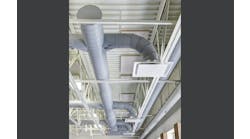If your university uses coal-fired boilers to power your central utility plant, the clock is now ticking.
In a little more than two years — February 2007 — those boilers will be required to comply with stricter emissions requirements passed into law earlier this year. The regulation, known as the National Emission Standards for Hazardous Air Pollutants for Industrial/Commercial/Institutional Boilers and Process Heaters, or Boiler MACT, is designed to reduce emissions of hazardous air pollutants (HAPs) by limiting the emissions of particulate matter, hydrochloric acid and mercury.
It is believed that more than 3,000 coal-fired industrial boilers nationwide are affected directly by Boiler MACT regulation. As many as 100 of those are on university campuses.
To date, however, only a few universities have completed the feasibility studies needed to determine if they will be in compliance or if they need to develop a corrective plan of action. Rather, most schools have taken a wait-and-see approach, waiting for the final regulations and seeing how other universities respond to them. In the meantime, many institutional facility managers want to know:
Q: Does Boiler MACT affect us?
It depends. If your university operations collectively emit more than 10 tons per year of any single HAP or 25 tons per year of any combination of HAPs, then your boilers will be subject to Boiler MACT requirements. Most universities that use coal-fired boilers are in this category.
If you are subject to Boiler MACT, the next step is to determine if the emissions from your coal-fired boilers will exceed the limits set by the Boiler MACT.
Every university's situation is unique. In general, if your coal-fired boilers use baghouses for emissions control, the Boiler MACT is expected to have little or no impact on your facility. However, if your coal-fired boilers do not use baghouses and instead rely on mechanical collectors or electrostatic precipitators for particulate matter control, compliance with Boiler MACT likely will require significant air-pollution-control modifications.
The only way to know for sure is by conducting a Boiler MACT study. For such an effort, you will need to look at such factors as boiler capacity, heat inputs, flue gas-flow rates and estimated emission rates to establish some baseline information. You may need to measure emission levels for each pollutant addressed in the new regulation to better determine your baseline emissions. By comparing baseline emissions with the emission limits established by the Boiler MACT, you can begin to assess what additional air-pollution-control measures, if any, are necessary.
Q: If we are affected, what kind of additional pollution-control measures might be necessary?
Upgrades can take many different forms. The “big-ticket” item that many institutions are concerned with is the addition of baghouses to their central utility plant. Sometimes referred to as “fabric filters,” a baghouse essentially is a large, multistory structure that contains large, tubular-shaped fabric bags that filter out particulate matter and mercury from the emissions gases much more efficiently than the mechanical collectors or electrostatic precipitators used at many plants. Fabric filters also can be retrofitted more easily with “add on” equipment such as spray coolers and sorbent injection systems to reduce emissions of other pollutants, if necessary.
Q: What does a baghouse cost?
The answer to this question, of course, depends largely on the circumstances at the site. It may be helpful to know, however, that capital costs for a single baghouse expected on most industrial boilers typically run in the range of $2 million to $5 million. When you factor in the cost of exhaust systems, foundations, electrical and mechanical systems, engineering and contingencies, total project costs can approach $10 million or more.
An unanticipated expense of this magnitude presents a challenge to many universities. A new baghouse is not something alumni typically are eager to raise money for. Hence, value-engineering solutions that enable a university to achieve compliance at the lowest possible cost are especially important.
Q: How might a university minimize its costs on a project like this?
The detailed work you perform upfront has the potential of paying cost-saving dividends down the road.
For example, consider the emission standards for mercury, which is a relatively new member of the family of pollutants subject to more stringent controls. Mercury is more difficult to remove than most other pollutants. What's more, mercury emissions also are known to vary significantly, depending on the type of coal a plant burns and other factors.
If you don't have detailed data indicating the variability of mercury concentrations in your coal or your plant's mercury emissions, you may end up installing more safety margin into your air-pollution-control equipment than you really need, just to ensure compliance. A thorough upfront study that includes characterization testing can optimize the design and result in lower upfront capital costs, while also minimizing operational and maintenance expenses.
Another possible way to minimize your pollution-control costs is by emissions averaging. Permitted by the Boiler MACT regulations — and if your state agency is your permitting authority, as long as your state EPA allows it — emissions averaging refers to a university's ability to total and average the emissions from all of the boilers subject to Boiler MACT on a campus. A university with two boilers, for example, may be required to upgrade only its pollution control equipment for one boiler, as long as the total average emissions from both fall within Boiler MACT guidelines.
Q: How soon do we need to begin any upgrades?
Affected coal-fired boilers are required to comply with the new standards three years after the final rule has been published in the Federal Register. This places the compliance date for Boiler MACT at Spring 2007. The permitting authority (U.S. EPA or your state agency), however, may grant one-year extensions to this deadline when circumstances warrant.
Still, that leaves only a relatively short window for universities to act. In the case of Purdue University, West Lafayette, Ind., (see sidebar), the entire process — from Boiler MACT study to baghouse startup — will take about two years. That schedule allows about six months for the regulatory reviews and feasibility studies, six months for process design and equipment purchasing, and about 12 months for baghouse fabrication and construction.
In developing the schedule for a university's upgrades, other factors also must be considered. For example, because ductwork and fans will need to be tied into existing systems, some phases of construction will need to be scheduled to coincide with major outages scheduled during the calendar year. Procedures and timeframes for obtaining funding and capital appropriations also need to be reviewed. Given the many compliance projects anticipated to meet the Boiler MACT over a relatively short period of time, the availability of qualified engineering/consulting firms, air-pollution-control equipment and system manufacturers, and installation contractors likely will become challenging issues. Update, November 2004: The Boiler MACT deadline has been changed to fall 2007.
Sidebar: Boilermakers
It's just a coincidence that Purdue University, home of the Boilermakers, was among the first universities to complete a Boiler MACT study.
Working with engineers, the university continued a process it had initiated internally to evaluate how the Boiler MACT would affect its Wade Utility Plant, which produces the steam that heats and cools the university's 38,000-student campus in West Lafayette, Ind. The study determined that the plant would be subject to Boiler MACT and would require significant air-pollution-control modifications. Several pollution-control alternatives were evaluated to determine the most cost-effective solution. The university is beginning detailed engineering on its compliance plan to meet the Boiler MACT.
Washam, PE, is project manager for Burns & McDonnell Engineering Company, Inc., St. Louis. The company worked on the Purdue project (see sidebar). Ridgway, PE, is an environmental regulatory consultant for Purdue University.
